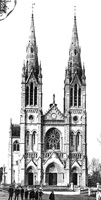|
 |
At the end of the XIXth century, Vimoutiers
is very prosperous, and
Notre-Dame Church seems too small ...
In 1888, is laid the first stone of a
2nd
Notre Dame Church, blessed in 1896.
In 1897, 439 years old
1st
Notre-Dame Church is
demolished and sold out for its mere building material value.
Thus the two Notre-Dame churches will have
coexisted for two brief
years on the Monks yard of Vimoutiers.
Charles-Florentin Loriot, poet, composed a
pretty testimony of this "duality".
About two churches @,
by Charles-Florentin Loriot
|
 |
"At the other end of
the public square, on the eastern side, the side of origins,
the old Church of Vimoutiers stands
and asserts in strong relief of dark stone mass against pale sky.
As Real as the
other church was ideal, it might have been painted by a Millet, and the
other by a Puvis.
The other was of
alabaster, this of bronze, if one may use metaphors to clarify.
It was through its
unicity that the new church
conveyed something of beauty.
But beauty is not only
unity, it is variety and if the old building reveals it,
one may say that it is
largely through the multiplicity of a hundred picturesque features,
each detail with its effect, each note singing its part,
every profile with its
character, every color its emotional appeal.
Here are stones,
sandy, and ruddy from the land, corroded by winters,
dislodged by the passage
on the market place of westerly winds in tumultuous winters
There, are fillets and
ornaments, lined with mosses and weeds.
There, is an entire bed
sown with flecks of gold of lichens, recalling the long attentiveness of many
suns.
Here color speaks :
the dark blue of slates complementing the dark orange of
walls,
like rusted steel beside
darkened brass.
There, it is the form
that
suggests, the church is geometrical. The steeple is square, it is a belfry.
It is closed, haunted by
some old bronze bell whose cracked voice we might hear as though it were waking from a long slumber.
On its
slated mantle, are sound holes, eyes, lucarnes,
a weathervane
suspending lead finials, strange reliefs, asperities like those of seashells.
One would believe to be in Norway looking out on ancient roofs inhabited
in early times by the dark genius of seamen from the North.
This church .. it is
traditional, it is the XVth, it is the XVIth, it is the XVIIth,
It is each of these ages
in which the stones were laid, in the changing forms of each preference,
with a view of an
eternal purpose."
@Translated from French by NJGJ & Martha